air filter Oldsmobile Aurora 1997 Owner's Manuals
[x] Cancel search | Manufacturer: OLDSMOBILE, Model Year: 1997, Model line: Aurora, Model: Oldsmobile Aurora 1997Pages: 404, PDF Size: 20.75 MB
Page 150 of 404
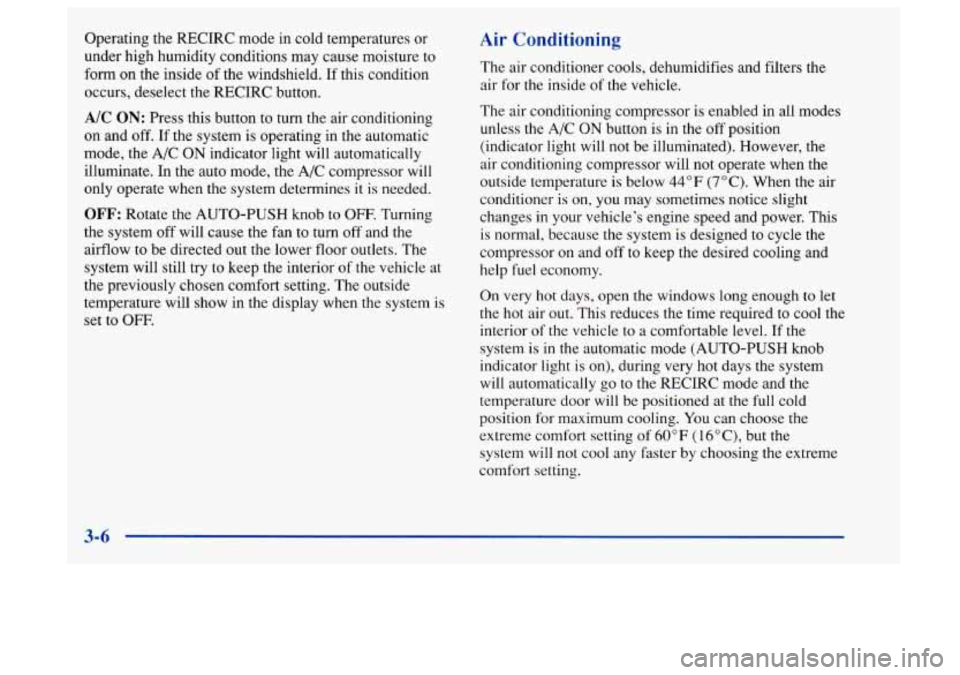
Operating the RECIRC mode in cold temperatures or
under high humidity conditions may cause moisture
to
form on the inside of the windshield. If this condition
occurs, deselect the RECIRC button.
A/C ON: Press this button to turn the air conditioning
on and
off. If the system is operating in the automatic
mode, the A/C
ON indicator light will automatically
illuminate. In the auto mode, the A/C compressor will
only operate when the system determines
it is needed.
OFF: Rotate the AUTO-PUSH knob to OFF. Turning
the system off will cause the fan to turn off and the
airflow to be directed
out the lower floor outlets. The
system will still try to keep the interior of the vehicle at
the previously chosen comfort setting. The outside
temperature will show in the display when the system is set to
OFF.
Air Conditioning
The air conditioner cools, dehumidifies and filters the
air for the inside of the vehicle.
The air conditioning compressor is enabled in all modes
unless the A/C
ON button is in the off position
(indicator light will not be illuminated). However, the
air conditioning compressor will not operate when the
outside temperature is below
44°F (7°C). When the air
conditioner is on,
you may sometimes notice slight
changes in your vehicle's engine speed and power. This
is normal, because the system is designed
to cycle the
compressor on and off to keep the desired cooling and
help
fuel economy.
On very
hot days, open the windows long enough to let
the hot air out. This reduces the time required to cool the
interior
of the vehicle to a comfortable level. If the
system
is in the automatic mode (AUTO-PUSH knob
indicator light is
on), during very hot days the system
will automatically
go to the RECIRC mode and the
temperature door will be positioned
at the full cold
position for maximum cooling. You can choose
the
extreme comfort setting of 60°F (16"C), but the
system
will not cool any faster by choosing the extreme
comfort setting.
Page 267 of 404
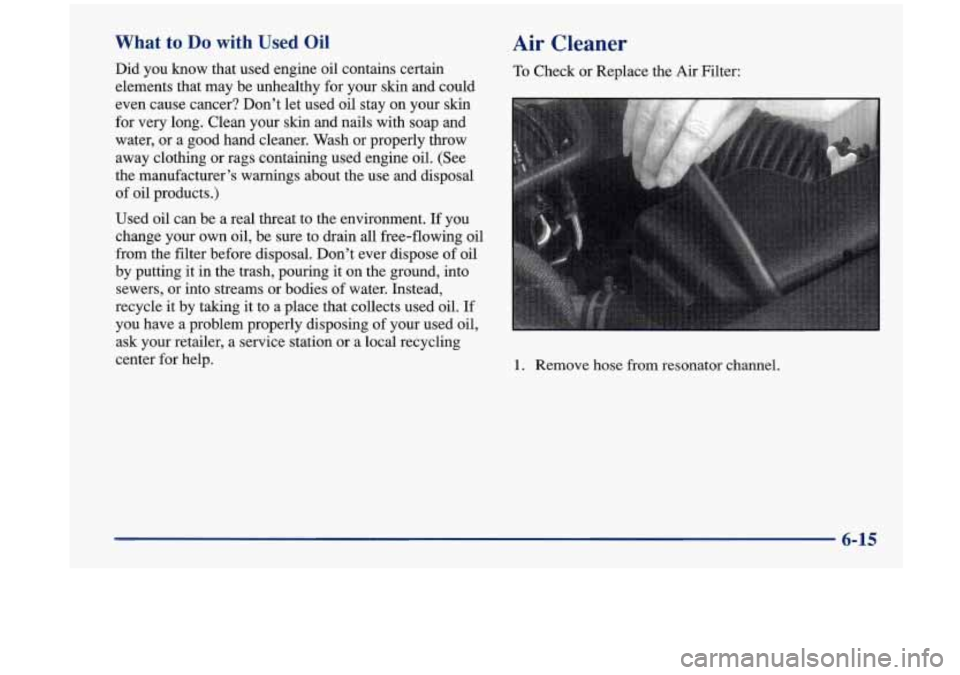
What to Do with Used Oil
Did you know that used engine oil contains certain
elements that may be unhealthy for your skin and could
even cause cancer? Don’t let used oil stay on your
skin
for very long. Clean your skin and nails with soap and
water, or a good hand cleaner. Wash or properly throw
away clothing or rags containing used engine oil. (See
the manufacturer’s warnings about the use and disposal
of oil products.)
Used oil can be a real threat to the environment. If you
change your own oil, be sure to drain all free-flowing oil
from the filter before disposal. Don’t ever dispose of oil
by putting it in the trash, pouring it on the ground, into
sewers, or into streams or bodies of water. Instead,
recycle it by taking it to a place that collects used
oil. If
you have a problem properly disposing of your used oil,
ask your retailer, a service station or a local recycling
center for help.
Air Cleaner
To Check or Replace the Air Filter:
1. Remove hose from resonator channel.
6-15
Page 269 of 404
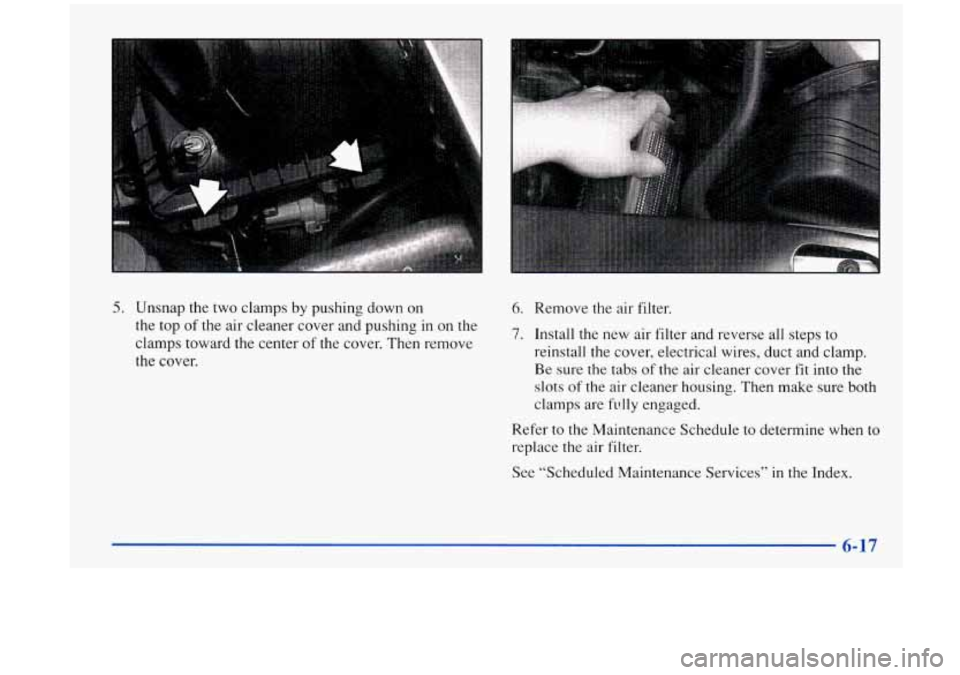
- , . .. .‘,. .
6. Remove the air filter. 5. Unsnap the two clamps by pushing down on
the top
of the air cleaner cover and pushing in on the
clamps toward the center
of the cover. Then remove
the cover. 7. Install the new air filter and reverse all steps to
reinstall the cover, electrical wires, duct and clamp.
Be sure
the tabs of the air cleaner cover fit into the
slots
of the air cleaner housing. Then make sure both
clamps are
fully engaged.
Refer
to the Maintenance Schedule to determine when to
replace the air filter.
See “Scheduled Maintenance Services”
in the Index.
6- 17
Page 270 of 404
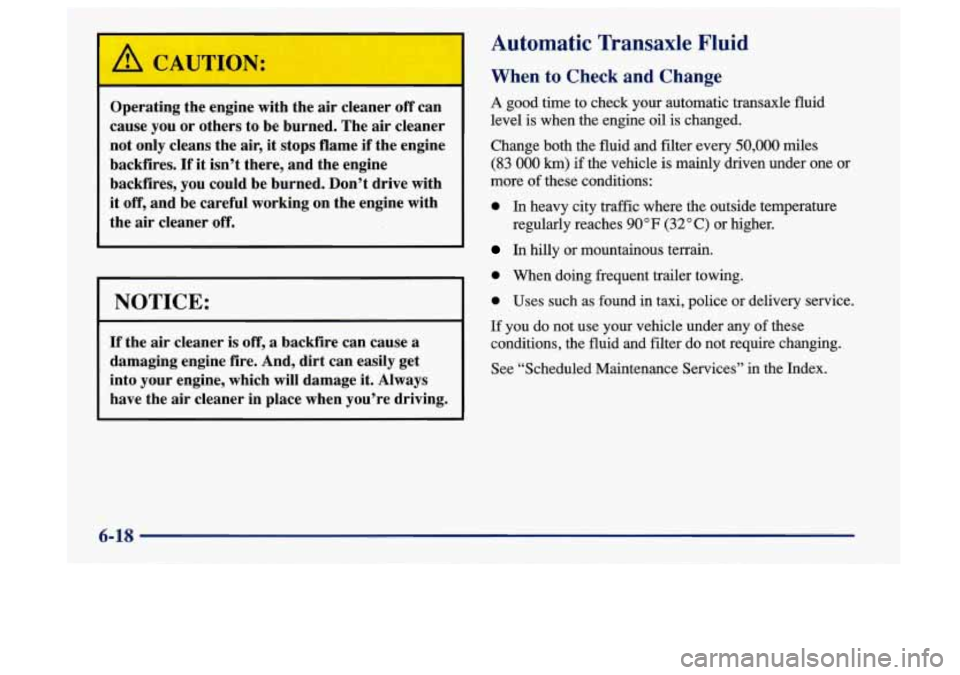
Operating the engine with the air cleaner off can
cause you or others to be burned. The air cleaner
not only cleans the air, it stops flame if the engine
backfires.
If it isn’t there, and the engine
backfires, you could be burned. Don’t drive with
it off, and be careful working on the engine with
the air cleaner
off.
NOTICE:
If the air cleaner is off, a backfire can cause a
damaging engine fire. And, dirt can easily get
into your engine, which will damage it. Always
have the air cleaner in place when you’re driving.
Automatic Transaxle Fluid
When to Check and Change
A good time to check your automatic transaxle fluid
level is when the engine oil is changed.
Change both the fluid and filter every
50,000 miles
(83 000 km) if the vehicle is mainly driven under one or
more of these conditions:
0 In heavy city traffic where the outside temperature
regularly reaches
90 OF (32 O C) or higher.
In hilly or mountainous terrain.
0 When doing frequent trailer towing.
0 Uses such as found in taxi, police or delivery service.
If you do not use your vehicle under any of these
conditions, the fluid and filter do not require changing.
See “Scheduled Maintenance Services” in the Index.
6-18
Page 325 of 404
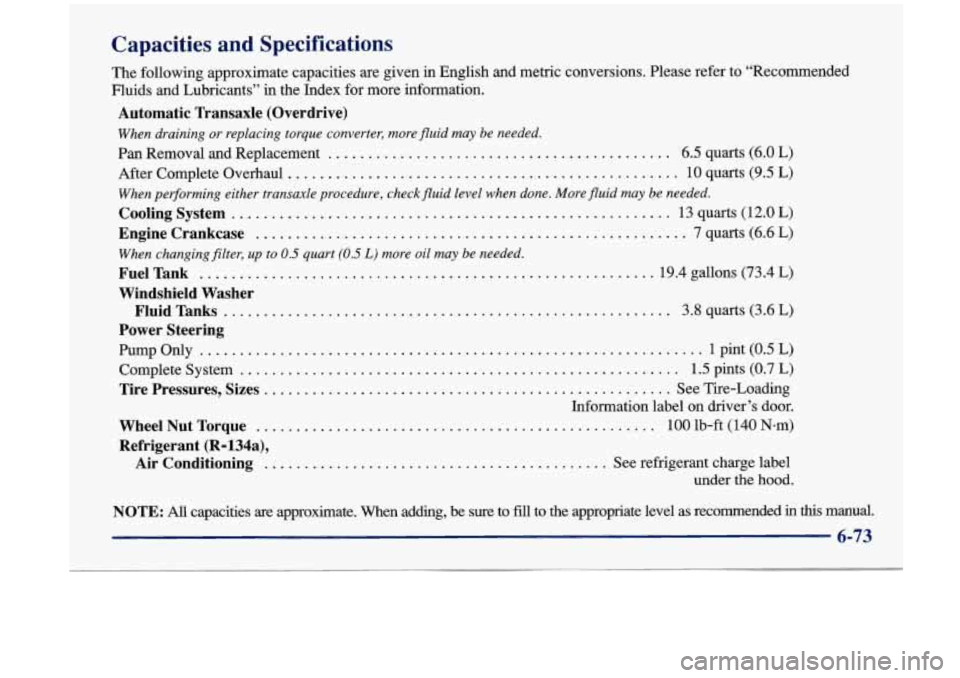
Capacities and Specifications
The following approximate capacities are given in English and metric conversions. rlease refer to “Recommended
Fluids
and Lubricants” in the Index for more information.
Automatic Transaxle (Overdrive)
When draining or replacing torque converter, more fluid may be needed.
Pan Removal and Replacement ........................................... 6.5 quarts (6.0 L)
After Complete Overhaul ................................................. 10 quarts (9.5 L)
When pe~orming either transaxle procedure, check fluid level when done. More fluid may be needed.
Cooling System ....................................................... 13 quarts (12.0 L)
Engine Crankcase ...................................................... 7 quarts (6.6 L)
When changing filter, up to 0.5 quart (0.5 L) more oil may be needed.
Fuel Tank ......................................................... 19.4 gallons (73.4 L)
Windshield Washer
Fluid Tanks
...................................................... 3.8 quarts (3.6 L)
Power Steering
Pump Only ............................................................... 1 pint (0.5 L)
Complete System ....................................................... 1.5 pints (0.7 L)
Tire Pressures, Sizes ................................................... See Tire-Loading
Information label on driver’s door.
Wheel Nut Torque .................................................. 100 lb-ft (140 N-m)
Refrigerant (R-l34a),
Air Conditioning
........................................... See refrigerant charge label
under the hood.
NOTE: All capacities are approximate. When adding, be sure to fd to the appropriate level as recommended in this manual.
6-73
Page 326 of 404
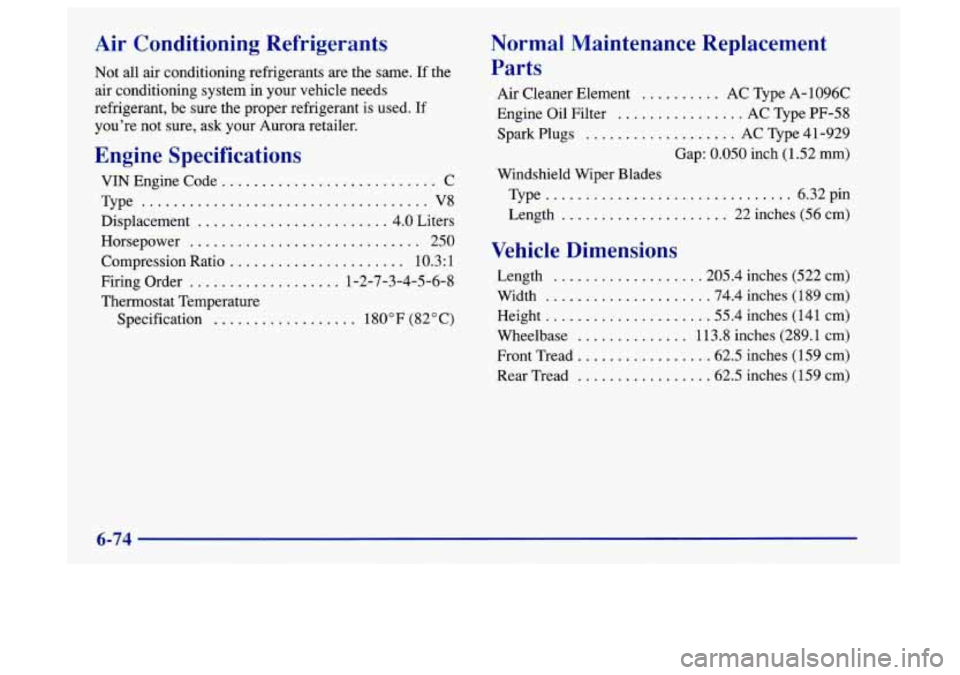
Air Conditioning Refrigerants
Not all air conditioning refrigerants are the same. If the
air conditioning system
in your vehicle needs
refrigerant, be sure the proper refrigerant is used. If
you’re not sure, ask your Aurora retailer.
Engine Specifications
VIN Engine Code ........................... C
Type
.................................... V8
Displacement ........................ 4.0 Liters
Horsepower
............................. 250
Firing Order
................... 1-2-7-3-4-5-6-8
Thermostat Temperature
Specification
.................. 180°F (82°C)
Compression Ratio
...................... 10.3:
1
Normal Maintenance Replacement
Parts
Air Cleaner Element .......... AC Type A- 1096C
Engine Oil Filter
................ AC Type PF-58
Spark Plugs
................... AC Type 41-929
Gap:
0.050 inch (1.52 mm)
Windshield Wiper Blades
Type
............................... 6.32pin
Length
..................... 22 inches (56 cm)
Vehicle Dimensions
Length .................. .205.4 inches (522 cm)
Width
.................... ,74.4 inches (189 cm)
Height
.................... .55.4 inches (141 cm)
Wheelbase
.............. 11 3.8 inches (289.1 cm)
Front Tread
................ .62.5 inches (159 cm)
Rear Tread
................ .62.5 inches (159 cm)
6-74
Page 333 of 404

Maintenance Schedule
I Short Trip/City Definition I
Follow the Short Trip/City Maintenance Schedule if any
one of these conditions is true for your vehicle:
0
0
0
0
0
Most trips are less than 5 to 10 miles (8 to 16 km).
This is particularly important when outside
temperatures are below freezing.
Most trips include extensive idling (such
as frequent
driving in stop-and-go traffic).
Most trips are through dusty areas.
You frequently tow a trailer or use a carrier on top of
your vehicle.
If the vehicle is used for delivery service, police, taxi
or other commercial application.
One of the reasons you should follow this schedule if
you operate your vehicle under any of these conditions
is that these conditions cause engine oil to break
down sooner.
Short Trip/City Intervals
Every 3,000 Miles (5 000 km): Engine Oil and Filter
Change (or
3 months, whichever occurs first).
(or
6 months, whichever occurs first). Tire Rotation.
Every 6,000 Miles (10 000 km): Chassis Lubrication
Every 30,000 Miles (50 000 km): Air Cleaner Filter
Replacement. Throttle Body Bore and Valve Plates
Inspection. Fuel Tank, Cap and Lines Inspection.
Service (severe conditions only).
Every 50,000 Miles (83 000 km): Automatic Transaxle
Every 60,000 Miles (100 000 km): Engine Accessory
Every 100,000 Miles (166 000 km): Spark Plug Wire
Every 150,000 Miles (240 000 km): Cooling System
Drive Belt
Inspection.
Inspection. Spark Plug Replacement.
Service (or every
60 months, whichever occurs first).
These intervals only summarize maintenance services.
Be sure
to follow the complete maintenance schedule on
the following pages.
Page 334 of 404
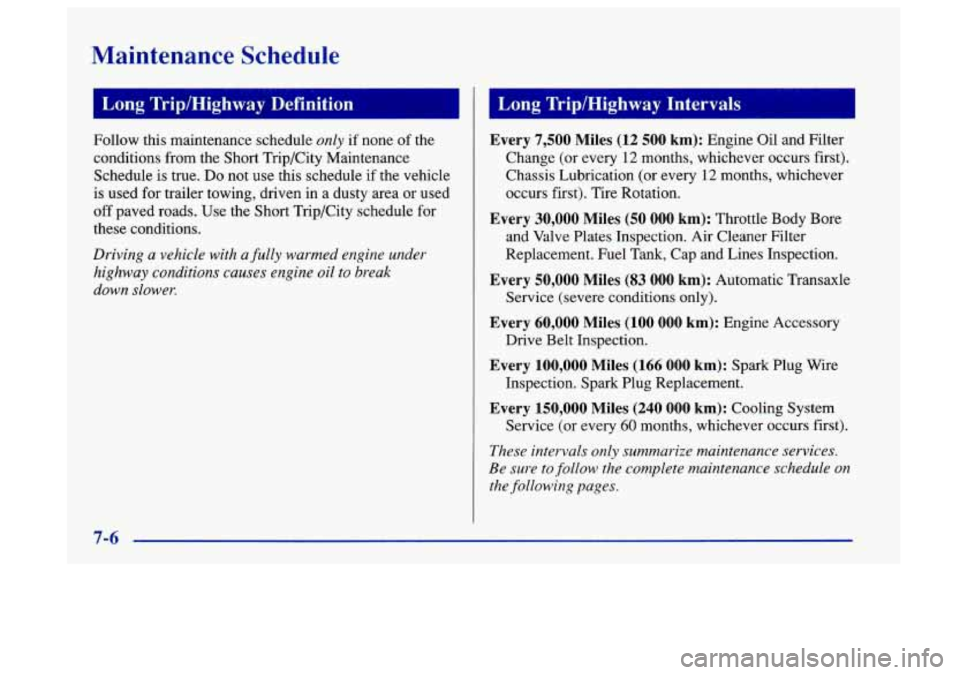
Maintenance Schedule
I Long Trip/Highway Definition I
Follow this maintenance schedule only if none of the
conditions from the Short Trip/City Maintenance
Schedule is true.
Do not use this schedule if the vehicle
is used
for trailer towing, driven in a dusty area or used
off paved roads. Use the Short Trip/City schedule for
these conditions.
Driving a vehicle with a fully warmed engine under
highway conditions causes engine oil to break
down slower.
Long Trip/Highway Intervals
1
Every 7,500 Miles (12 500 km): Engine Oil and Filter
Change (or every
12 months, whichever occurs first).
Chassis Lubrication (or every
12 months, whichever
occurs first). Tire Rotation.
Every 30,000 Miles (50 000 km): Throttle Body Bore
and Valve Plates Inspection. Air Cleaner Filter
Replacement. Fuel Tank, Cap and Lines Inspection.
Every 50,000 Miles (83 000 km): Automatic Transaxle
Every 60,000 Miles (100 000 km): Engine Accessory
Service (severe conditions
only).
Drive Belt Inspection.
Every 100,000 Miles (166 000 km): Spark Plug Wire
Every 150,000 Miles (240 000 km): Cooling System
Inspection. Spark Plug Replacement.
Service
(or every 60 months, whichever occurs first).
These intervals only summarize maintenance services.
Be sure
to follow the complete maintenance schedule on
the following pages.
Page 340 of 404
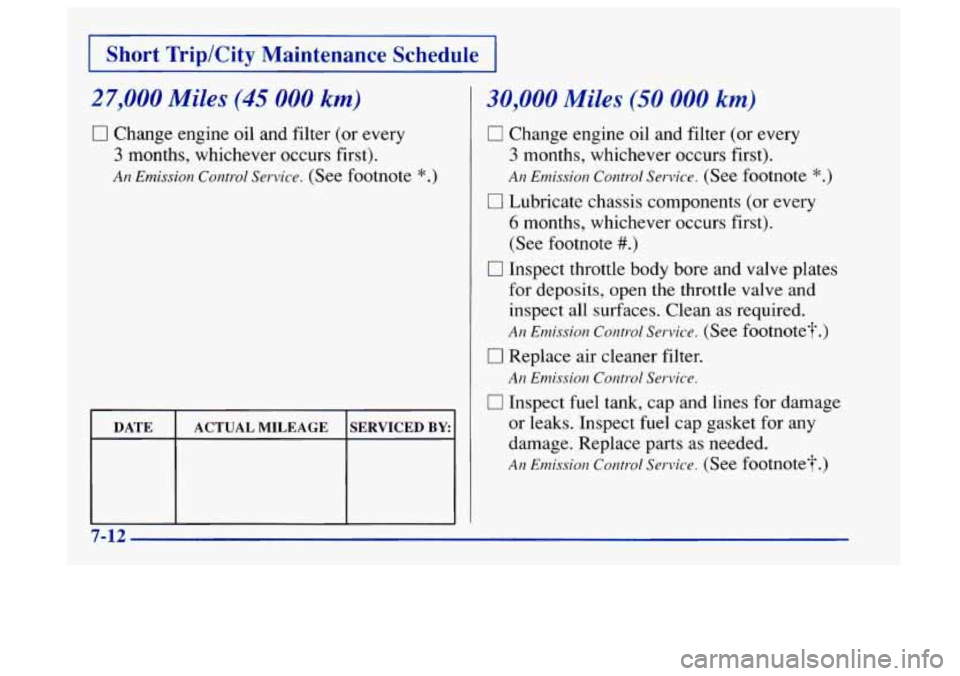
Short Trip/City Maintenance Schedule
27,000 Miles (45 000 km)
0 Change engine oil and filter (or every
3 months, whichever occurs first).
An Emission Control Service. (See footnote *.)
I DATE I ACTUAL MILEAGE ISERVICED BY:^
30,000 Miles (50 000 km)
0 Change engine oil and filter (or
Jery
3 months, whichever occurs first).
An Emission Control Service. (See footnote *.)
6 months, whichever occurs first).
(See footnote
#.)
0 Inspect throttle body bore and valve plates
for deposits, open
the throttle valve and
inspect all surfaces. Clean as required.
An Emission Control Service. (See footnote?.)
17 Lubricate chassis components (or every
0 Replace air cleaner filter.
AII Emission Control Service.
0 Inspect fuel tank, cap and lines for damage
or leaks. Inspect fuel cap gasket for any
damage. Replace parts as needed.
An Emission Control Service. (See footnote?.)
7-12
Page 346 of 404

I Short Trip/City Maintenance Schedule I
57,000 Miles (95 000 km)
0 Change engine oil and filter (or every
3 months, whichever occurs first).
An Emission Control Service. (See footnote *.)
DATE
SERVICED BY ACTUAL MILEAGE
60,000 Miles (100 000 km)
0 Change engine oil and filter (or every
3 months, whichever occurs first).
An Emission Com*o1 Service. (See footnote *.)
6 months, whichever occurs first).
(See footnote
#.)
0 Inspect throttle body bore and valve plates
for deposits,
open the throttle valve and
inspect all surfaces. Clean as required.
An Emission Control Service. (See footnote?.)
0 Lubricate chassis components (or every
0 Inspect engine accessory drive belt.
An Emission Control Service.
0 Replace air cleaner filter.
An Emission Control Service.
7-18